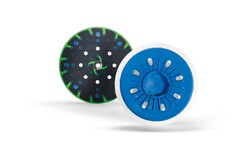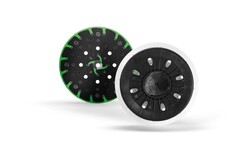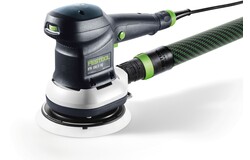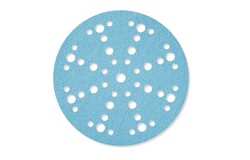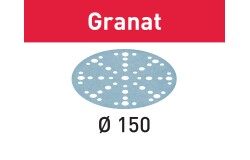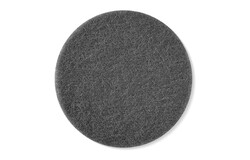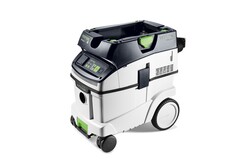Sanding mineral material panels to a semi-matt finish

Description
This application example can also be used for materials such as Varicor®, Avonit®, Marlan®, Corian® etc.
GetaCore® is a versatile surface material ideal for designing elegant room interiors. GetaCore® is an acrylic-based mineral material with a pore-free surface. The mineral material panel is completely impermeable, food safe, easy to maintain and largely resistant to chemicals.
The material is used primarily in kitchen, office, clinic and shop furnishings and creates the same effect as marble and granite.
Prior to delivery, the surface of the mineral material panel is fine-sanded with a belt sander using P 240 to P 600 grit. The finished surface must be finely sanded without visible traces of the sanding direction. With the ROTEX and the Festool sanding discs, polymer materials can be sanded quickly, dust-free and efficiently.
Tools/accessories
Alternative tools
Preparation/set-up
-
Coarse sanding:
First sand rough adhesive seams and material protrusions in the mineral material panel using the ROTEX, a hard sanding pad and with Granat® abrasive and grit size P 120 in the coarse sanding setting.
-
Fine sanding:
The surface of the mineral material panel is then fine sanded with Granat up to grit size P 1500, Platin 2 up to S 4000 and the soft sanding pad.
You can complete this step using the ROTEX with fine sanding settings or the ETS 150/3.
However, we recommend using the ETS 150/3 with a smaller sanding stroke because it leaves behind fewer sanding marks on the mineral material panel when there are dark and sensitive colours. Even if the mineral material panel is to be polished at a later stage, the ETS 150/3 is the preferred machine for sanding.
-
The interface pad should be used for joins and curves. The pad is affixed between the sanding pad and abrasive. This achieves optimal support between the abrasive paper and the mineral material panel during sanding.
ROTEX RO 150 setting
Speed: 6
Sanding motion: Eccentric sanding
Sanding pads: ST-STF D150/MJ2-FX-W-HT Interface Pad (optional)
Abrasives: Granat P 120 – P 1500 Platin® 2 S 2000 – S 4000
ETS/3 setting
Speed: 6
Sanding pads: ST-STF D150/MJ2-M8-W-HT Interface Pad (optional)
Abrasives: Granat P 120 – P 1500
Platin® 2 S 2000 – S 4000
Procedure
-
Coarse sanding:
- Affix the hard sanding pad to the ROTEX® RO 150.
- Connect the extractor hose to the ROTEX® RO 150.
- Carry out preliminary sanding of the mineral material panel with Granat abrasive, grit P120, in coarse sanding setting with cross sanding.

-
Fine sand to a silk gloss finish or prepare for polishing with the ETS 150/3:
- Affix the soft sanding pad and sand using Granat® abrasive, grit P 180, P 280, P 500, P 1200 and P 1500.
- For curved joins, place the optional interface pad between the sanding pad and the sanding disc.

-
Final surface sanding with Platin® 2 S 2000 and S 4000 should produce a semi-matt shine on the surface. This surface of the mineral material panel is usually adequate for everyday use.
Depending on the mineral material used, some sanding steps may not be necessary. With bright shades, a semi-matt finish can also be achieved with Granat P120, P240, P400 and finally Platin S500.
Important information relating to problematic colours such as black or dark red:
The grit stages for sanding should be finer here.- Granat P 180
- Granat P 240
- Granat P 320
- Granat P 400
- Granat P 800
- Granat P 1200
- Granat P 1500
- Platin 2 P 2000
- Platin 2 P 4000
Prevents visible sanding marks, which is particularly important if you intend to polish dark colours.

-
Fine sanding for a matt finish with the ETS 150/3:
- Speed setting level 6
- Soft sanding pad M8-W-HT
- Abrasive Granat P 120
- Abrasive Granat P 240
- Even matting of the surface through cross sanding with sanding cloth S800
- Remove sanding dust using a damp cleaning cloth

-
The dust generated when sanding GetaCore® is extra fine. Always work with a dust extractor and integral filter bag to protect the user and the machine (e.g. CTM mobile dust extractor).
Tips:- You should generally always apply minimal pressure when sanding.
- Hard sanding pad for sanding away scratches and flush sanding of residual adhesive, soft sanding pad for flat surfaces and ultra-soft sanding pads for curves and inner radii.
- After every sanding stroke, wipe down the mineral material panel with a clean, damp cloth.
- Do not sand the mineral material panel with the same abrasive paper for too long: Risk of groove formation.

-
Our illustrated guides and work results are documented working steps that we have performed in practice. They are individual examples and do not guarantee or promise that users will obtain the same results. The results will depend on the user's experience and skill, as well as the material being used. Illustrated guides do not replace any Festool operating manuals and/or safety instructions. Liability for ensuring that the information, instructions and applications are free from content defects and defects of title, in particular with regard to the absence of defects, correctness, freedom from third party intellectual property rights and copyrights, completeness and fitness for purpose, is excluded. Claims for damages made by the user, regardless of their legal basis, are excluded. These liability exclusions are not applicable if the damage was intentional or caused by gross negligence, or in cases of statutory liability.
We cannot accept liability for damage resulting from defects.↑








































